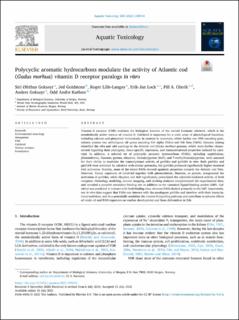| dc.description.abstract | Vitamin D receptor (VDR) mediates the biological function of the steroid hormone calcitriol, which is the metabolically active version of vitamin D. Calcitriol is important for a wide array of physiological functions, including calcium and phosphate homeostasis. In contrast to mammals, which harbor one VDR encoding gene, teleosts possess two orthologous vdr genes encoding Vdr alpha (Vdra) and Vdr beta (Vdrb). Genome mining identified the vdra and vdrb paralogs in the Atlantic cod (Gadus morhua) genome, which were further characterized regarding their phylogeny, tissue-specific expression, and transactivational properties induced by calcitriol. In addition, a selected set of polycyclic aromatic hydrocarbons (PAHs), including naphthalene, phenanthrene, fluorene, pyrene, chrysene, benzo[a]pyrene (BaP), and 7-methylbenzo[a]pyrene, were assessed for their ability to modulate the transcriptional activity of gmVdra and gmVdrb in vitro. Both gmVdra and gmVdrb were activated by calcitriol with similar potencies, but gmVdra produced significantly higher maximal fold activation. Notably, none of the tested PAHs showed agonistic properties towards the Atlantic cod Vdrs. However, binary exposures of calcitriol together with phenanthrene, fluorene, or pyrene, antagonized the activation of gmVdra, while chrysene and BaP significantly potentiated the calcitriol-mediated activity of both receptors. Homology modeling, solvent mapping, and docking analyses complemented the experimental data, and revealed a putative secondary binding site in addition to the canonical ligand-binding pocket (LBP). Calcitriol was predicted to interact with both binding sites, whereas PAHs docked primarily to the LBP. Importantly, our in vitro data suggest that PAHs can interact with the paralogous gmVdrs and interfere with their transcriptional activities, and thus potentially modulate the vitamin D signaling pathway and contribute to adverse effects of crude oil and PAH exposures on cardiac development and bone deformities in fish. | |
